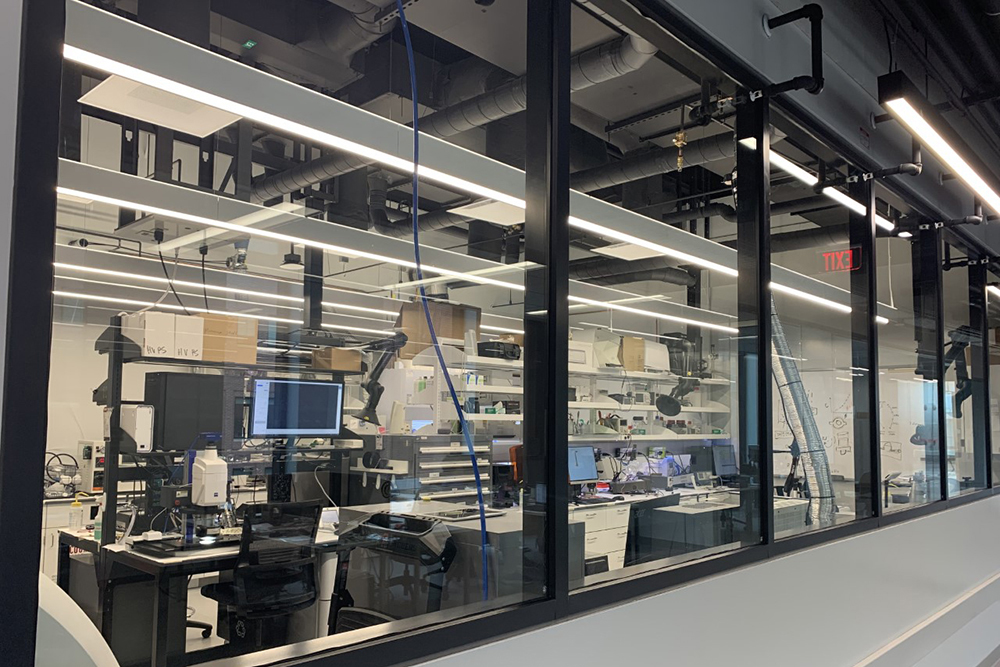Calendar Icon
Mar 03, 2022
Person Bust Icon
By Karl Vogel
![]() RSS
Submit a Story
RSS
Submit a Story

With faculty moving into the 50-plus new laboratories and students now using collaborative work and study spaces, the Engineering Research Center (ERC) is positioned to help transform research being conducted in the College of Engineering.
The 87,000-square foot ERC houses labs from across the college on three primary levels, with an emphasis on materials, biomedical topics, and light-matter interactions. Nearly all of the laboratories designated for this new space have been relocated with a few research teams still to come this spring.
Mark Riley, associate dean for research, said the ERC is designed with connections and visibility at the forefront, providing the opportunity to put innovative and transformative research in a new spotlight.
"The design of the ERC facilitates interaction between groups doing similar kinds of experimentation with shared equipment corridors connecting laboratories but separated from the primary floor traffic on each level," Riley said. "Previously, some of the creative work of our faculty, students and staff has been hidden behind cinderblock walls. It is exciting to show off the amazing technology and creative works of our researchers."
The ERC is the first part of the $75 million Phase 1 engineering facilities project while also modernizing the look of the college's City Campus footprint.
On the exterior, the three-story facility features a West-facing entrance with an all-glass window façade that allows for panoramic views along 16th Street and reflects the emphasis on cutting-edge research. The ERC will also feature a coffee shop to enhance the experiences of faculty and students.
Shudipto Dishari, assistant professor of chemical and biomolecular engineering, said having a new, modernized lab in this building dedicated to research will be a boon to her team's work.
"At ERC, we have dedicated lab spaces for wet chemistry, soft materials design and characterization," Dishari said. "This state-of-the-art facility will have a profound impact on our paradigm-shifting materials innovation efforts for energy and biomedical fields and allow us to continue to strive for research excellence."
Having researchers working in the same fields now in close proximity to each other will have many benefits, said Eric Markvicka, assistant professor of mechanical and materials engineering who directs the Smart Materials and Robotics Laboratory.
"This represents a transformational change for Nebraska Engineering," said Markvicka. "It provides a vibrant and well-equipped scientific research environment that promotes cross talk, innovation and collaboration between research groups and across disciplines, and offers world-class research opportunities for undergraduate and graduate students to tackle global challenges in engineering, material science and medicine."
Among the researchers coming together in one of the new clusters are Ryan Pedrigi and Ruiguo Yang, who both work in the field of mechanobiology in which they seek to understand how cells respond to mechanical stimuli and how that can be leveraged to understand diseases and develop new therapeutics.
Though they are working on separate projects, the new facilities create a new sense of community that will benefit everyone, especially students, said Pedrigi, assistant professor of mechanical and materials engineering.
"Doing work in a cutting-edge lab space that contains all the necessary facilities gives students more confidence and motivation to continue their efforts of overcoming challenging obstacles. It also provides better research experiences that deepen student learning," added Pedrigi.
"Our teams can work alongside each other, learn from the different techniques being used, and easily pool knowledge to help overcome technical barriers. Such experiences are critical for students who need to develop highly interdisciplinary research expertise to be successful as professionals."
In addition, the ERC provides a significant physical upgrade in the laboratories themselves that will also benefit research conducted there.
Craig Zuhlke, research assistant professor of electrical and computer engineering, is co-director of the Center for Electro-Optics and Functionalized Surfaces. That lab is moving from a space in the outdated Scott Engineering Center (SEC) to a location in the ERC that is better suited for modern equipment.
"(SEC) had to be retrofitted for the modern research equipment like high-powered lasers being used in many labs," Zuhlke said. "The new location of the optics labs (CEFS) on the ground floor is a major improvement in reducing vibrations that were often an issue with optical and materials science equipment in SEC."
Phase 1 began in November 2019 with the demolition of the 25,307-square foot Link, which connected Nebraska Hall and Scott Engineering Center (SEC) and housed the departments of civil and environmental engineering and electrical and computer engineering.
Work on Phase 1 will be finished in 2023 when the renovation of 68,000 square feet in SEC is completed, creating additional high-tech research labs, department offices and classrooms. Also underway is Phase 2 of the facilities project, featuring the $115 million Kiewit Hall dedicated to engineering education.
Submit a Story